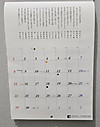365haiku 
2025年7月12日 (土)
2025年7月11日 (金)
俳句 365 haiku (191) 《夏蝶 Kunpūshi》
夏蝶飛来アメリカ館の映像へ
(natsuchō-hirai amerikakan-no-eizō-e)
(薫風士)
a summer butterfly
strayed into the wall-display_
the US pavilion
(Lovee)
Click or tap here to see the latest article of “俳句 365 haiku”.
2025年7月10日 (木)
俳句 365 haiku (190) 《夕涼み Kunpūshi》
万博のドローンショー愛で夕涼み
(banpaku-no dorōn-shō-mede yūsuzumi)
(薫風士)
evening cool;
enjoying displays of drone show
EXPO 2025
(Lovee)
This picture shows a scenery viewed from the grand ring roof of EXPO 2025 on July 9, 2025.
Click here and see "俳句 365 haiku (161)《夜の万博 Kunpūshi》".
Click or tap here to see the latest article of “俳句 365 haiku”.
俳句 365 haiku (189) 《牡丹5 Seiho》
牡丹百二百三百門一つ
(botan-hyaku nihyaku-sanbyaku mon-hitotsu)
(阿波野青畝)
peony flowers_
one-hundred two-hundred three-hundred
one-gate
(Translated by Lovee)
Click or tap here to see the latest article of “俳句 365 haiku”.
2025年7月 8日 (火)
俳句 365 haiku (188) 《夕立 Kunpūshi》
大夕立手作り庭を見とれけり
(ōyudachi tezukuri-niwa-o mitore-keri)
(薫風士)
heavy shower
enchanted me to gaze at
the garden of my own making
(Lovee)
Click or tap here to see the latest article of “俳句 365 haiku”.
2025年7月 7日 (月)
俳句 365 haiku (187) 《牡丹4 Shūson》
火の奥に牡丹崩るるさまを見つ
(hi-no-oku-ni botan-kuzururu sama-o-mitsu)
(加藤楸邨)
looking back at the peony flowers
crumbling beyond (air-raid) fires
(burning our home)
(Translated by Lovee)
(Note)
In the above translation, the words in parentheses are supplemented by considering Shūson’s prefatory note on this haiku to the following effect:
“May 23, at midnight, air raids by large formation, with my wife I carried my sick brother on my back and looked for Michiko and Akio all night through the flames.”
Click or tap here to see the latest article of “俳句 365 haiku”.
2025年7月 6日 (日)
俳句 365 haiku (186) 《牡丹3 Kyoshi》
白牡丹といふといへども紅ほのか
(hakubotan-to yūto-iedomo ko- honoka)
(高浜虚子)
white rose,
so called, but
slightely tinged with red
(Translated by Lovee)
Click or tap here to see the latest article of “俳句 365 haiku”.
2025年7月 5日 (土)
俳句 365 haiku (185) 《牡丹2 Buson》
(botan-chirite uchikasanari-nu nisan-pen)
(蕪村) (Translated by Lovee)
peony flower;
on top of one another,
two or three petals have fallen
Click or tap here to see the latest article of “俳句 365 haiku”.
2025年7月 4日 (金)
俳句 365 haiku (184) 《牡丹1 Bashō》
牡丹蘂ふかく分出る蜂の名残哉
(botan-shibe fukaku-wakeizuru hachi-no-nagori-kana)
(芭蕉)
sorrow of parting,
bee’s pushing its way
out of botan-shibe;
(Translated by Lovee)
(Note)
Bashō composed this haiku for appreciation of hearty hospitality to him when he visited his disciple.
Thus, the bee implies Bashō and the botan-shibe, which means stamen or pistil of peony, is a metaphor of his disciple.
Click or tap here to see the latest article of “俳句 365 haiku”.
2025年7月 3日 (木)
俳句 365 haiku (183) 《半夏生2 Kunpūshi》
万博の一見の価値半夏生
(banpaku-no ikken-no-kachi hangeshō)
(薫風士)
value of seeing
EXPO 2025:
hangeshō
(Note)
In this haiku, the term “hangeshō”, which means a name of flower, is used as a metaphor.
This picture shows a partial portion of hangeshō in "季節の花300”.
Click or tap here to see the latest article of “俳句 365 haiku”.
2025年7月 2日 (水)
俳句 365 haiku (182) 《ほたるBuson》
学問は尻から抜けるほたる哉
(gakumon-wa shiri-kara-nukeru hotaru-kana)
(与謝蕪村)
firefly_
learning will come out
from butt
(Translated by Lovee)
Click or tap here to see the latest article of “俳句 365 haiku”.
2025年7月 1日 (火)
俳句 365 haiku (181) 《半夏生1 Kunpūshi》
万博の抽選外れ半夏生
(banpaku-no chūsen-hazure hangeshō)
(薫風士)
hangeshō_
failures in getting admissions by lot;
EXPO 2025 pavilions
(Note)
The term “hangeshō” means “ the eleventh day (July 1) after the summer solstice,” as well as a name of flower.
This picture shows a part of calender for July, 2025, which is provided by Association of Japanese Classical Haiku(日本伝統俳句協会).
Click or tap here to see the latest article of “俳句 365 haiku”.
2025年6月30日 (月)
俳句 365 haiku (180) 《夏越Kunpūshi》
(banpaku-no tōsen inoru sora-nagoshi)
(薫風士)
sky of Nagoshi_
praying for winning admissions
EXPO 2025
Click or tap here to see the latest article of “俳句 365 haiku”.
2025年6月29日 (日)
俳句 365 haiku (179) 《炎天Kunpūshi》
炎天下パビリオン前列長蛇
(enten-ka pabirion-mae retsu-chōda)
(薫風士)
various pavilions
in sweltering heat_
long rows of visitors
(Lovee)
(Note)
Based on the catchphrase of EXPO 2025 “Designing Future Society for Our Lives”, the current situation of EXPO 2025 should be redesigned immediately for the enjoyment of visitors.
Click here to see the current situation of EXPO 2025 by "万博レポ1《俳句と写真集》" of "俳句HAIKU".
Click or tap here to see the latest article of “俳句 365 haiku”.
2025年6月28日 (土)
俳句 365 haiku (178) 《白南風4 Kunpūshi》
白南風に杉の香仄か大リング
(shirohae-ni sugi-no-ka-honoka ōringu)
(薫風士)
balmy winds after the rainy season_
faint scent of sugi-timbers;
EXPO’s grand-ring
(Lovee)
Click or tap here to see the latest article of “俳句 365 haiku”.
2025年6月27日 (金)
俳句 365 haiku (177) 《蛍2 Issa》
大蛍ゆらりゆらりと通りけり
(ōbotaru yurariyurari-to tōri-keri)
(一茶)
a big firefly
has passed
leisurely swaying
(Translated by Lovee)
Click or tap here to see the latest article of “俳句 365 haiku”.
2025年6月26日 (木)
俳句 365 haiku (176) 《白南風3 Kunpūshi》
白南風や眼鏡新調壮快ぞ
(shirohae-ya megane-shinchō sōkai-zo)
(薫風士)
new spectacles of right strength;
balmy winds upon end of the rainy season_
pleasant!
(Lovee)
Click or tap here to see the latest article of “俳句 365 haiku”.
2025年6月25日 (水)
俳句 365 haiku (175) 《梅雨晴間3 Kunpūshi》
梅雨晴間万博客の列長蛇
(tsuyuharema banpaku-kyaku-no retsu-chōda)
(薫風士)
sunny day during the rainy season_
long rows of visitors:
EXPO 2025
(Lovee)
Click or tap here to see the latest article of “俳句 365 haiku”.
2025年6月24日 (火)
俳句 365 haiku (174) 《白南風2 Kunpūshi》
白南風に新聞の香や眼鏡店
(shirohae-ni shinbun-no-ka megane-ten)
(薫風士)
faint scent of newspapers
at a shop of spectacles_
balmy winds after the rainy season
(Lovee)
(Note)
Please note that the word “新聞の香” (shinbun-no-ka) in this haiku means a fresh scent of newspapers, not a musty smell of rainy season.
Click or tap here to see the latest article of “俳句 365 haiku”.
2025年6月23日 (月)
俳句 365 haiku (173) 《沖縄忌Kunpūshi》
おばあちゃんの唄を詩にし子沖縄忌
(obāchan-no uta-o shi-ni-shi-ko okinawaki)
(薫風士)
boy in fifth-grade
cited grandma’s song in his poem_
Okinawaki
(Lovee)
(Note)
The term “Okinawaki” means a memorial day for consoling all spirits of the people who died from the battles in Okinawa during the Pacific War.
These pictures show partial portions of NHK-TV scenes which Kunpūshi watched on June 23, 2025.
Click or tap here to see the latest article of “俳句 365 haiku”.



























